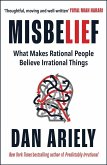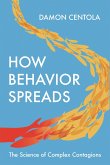- Gebundenes Buch
- Merkliste
- Auf die Merkliste
- Bewerten Bewerten
- Teilen
- Produkt teilen
- Produkterinnerung
- Produkterinnerung
This text is a comprehensive, practical presentation of the principles of behavior modification and guidelines for their application. It introduces forms of behavior modification ranging from helping children learn necessary life skills to solving personal behavior problems.
Andere Kunden interessierten sich auch für
![Misbelief Misbelief]() Dan ArielyMisbelief8,49 €
Dan ArielyMisbelief8,49 €![The Social Instinct The Social Instinct]() Nichola RaihaniThe Social Instinct8,99 €
Nichola RaihaniThe Social Instinct8,99 €![The Evolution of Ethics in America The Evolution of Ethics in America]() Laurence Armand FrenchThe Evolution of Ethics in America202,99 €
Laurence Armand FrenchThe Evolution of Ethics in America202,99 €![People and Spaces People and Spaces]() People and Spaces206,99 €
People and Spaces206,99 €![How Behavior Spreads How Behavior Spreads]() Damon CentolaHow Behavior Spreads49,99 €
Damon CentolaHow Behavior Spreads49,99 €![From Crowd Psychology to the Dynamics of Large Groups From Crowd Psychology to the Dynamics of Large Groups]() Carla PennaFrom Crowd Psychology to the Dynamics of Large Groups194,99 €
Carla PennaFrom Crowd Psychology to the Dynamics of Large Groups194,99 €![Fool Proof Fool Proof]() Tess Wilkinson-RyanFool Proof22,99 €
Tess Wilkinson-RyanFool Proof22,99 €-
-
-
This text is a comprehensive, practical presentation of the principles of behavior modification and guidelines for their application. It introduces forms of behavior modification ranging from helping children learn necessary life skills to solving personal behavior problems.
Hinweis: Dieser Artikel kann nur an eine deutsche Lieferadresse ausgeliefert werden.
Hinweis: Dieser Artikel kann nur an eine deutsche Lieferadresse ausgeliefert werden.
Produktdetails
- Produktdetails
- Verlag: Taylor & Francis Ltd
- 12. Auflage
- Seitenzahl: 390
- Erscheinungstermin: 23. Januar 2024
- Englisch
- Abmessung: 280mm x 210mm
- Gewicht: 911g
- ISBN-13: 9781032233147
- ISBN-10: 1032233141
- Artikelnr.: 68711276
- Herstellerkennzeichnung
- Libri GmbH
- Europaallee 1
- 36244 Bad Hersfeld
- gpsr@libri.de
- Verlag: Taylor & Francis Ltd
- 12. Auflage
- Seitenzahl: 390
- Erscheinungstermin: 23. Januar 2024
- Englisch
- Abmessung: 280mm x 210mm
- Gewicht: 911g
- ISBN-13: 9781032233147
- ISBN-10: 1032233141
- Artikelnr.: 68711276
- Herstellerkennzeichnung
- Libri GmbH
- Europaallee 1
- 36244 Bad Hersfeld
- gpsr@libri.de
Garry Martin is internationally known for his nine co-authored or co-edited books, 177 journal articles, and 106 invited conference presentations in six countries on various areas in Behavioral Modification, including intellectual disability, autism spectrum disorder, and sport psychology. He has received numerous honors and awards including the Distinguished Contribution Award from the Canadian Psychological Association and an induction into the Royal Society of Canada. Joseph Pear was internationally known for his work in both Basic and Applied Behavior Analysis. In addition to co-authoring this book with Garry, he has authored two other books and authored or co-authored 12 book chapters, six encyclopedia entries, seven published conference proceedings, two invited newsletter contributions, 60 invited conference presentations and symposia, and 57 peer-reviewed journal articles in diverse areas of Basic and Applied Behavior Analysis. He has received numerous awards and distinctions, including being elected a fellow in both Division 6 ("Society for Behavioral Neuroscience and Comparative Psychology") and Division 25 ("Behavior Analysis") of the American Psychological Association.
Preface
About the 12th Edition of This Book
Changes in the 12th Edition
Digital Materials for Professors and Students: Test Questions
Practica
PowerPoint Slide Material
and Flashcards
To the Student
Acknowledgments
Using This Book to Study for the Behavior Analysis Certification Board® Examinations
PART I. THE BEHAVIOR MODIFICATION APPROACH
CHAPTER 1 Introduction
CHAPTER 2. Areas of Application: An Overview
CHAPTER 3. Defining
Measuring
and Recording Target Behavior
CHAPTER 4. Doing Behavior Modification Research
PART II. BASIC BEHAVIORAL PRINCIPLES AND PROCEDURES
CHAPTER 5. Respondent (Classical
Pavlovian) Conditioning of Reflexive Behavior
CHAPTER 6. Increasing a Behavior With Positive Reinforcement
CHAPTER 7. Increasing Behavior With Conditioned Reinforcement
CHAPTER 8. Decreasing a Behavior With Operant Extinction
CHAPTER 9. Getting a New Behavior to Occur With Shaping
CHAPTER 10. Developing Behavioral Persistence With Schedules of Reinforcement
CHAPTER 11. Responding at the Right Time and Place: Operant Stimulus Discrimination and Stimulus Generalization
CHAPTER 12. Changing the Stimulus Control of a Behavior With Fading
CHAPTER 13. Getting a New Sequence of Behaviors to Occur With Behavior Chaining
CHAPTER 14. Differential Reinforcement Procedures to Decrease Behavior
CHAPTER 15. Decreasing Behavior With Punishment
CHAPTER 16. Establishing Behavior by Escape and Avoidance Conditioning
CHAPTER 17. Respondent and Operant Conditioning Together
CHAPTER 18. Transferring Behavior to New Settings and Making It Last: Programming of Generality of Behavior Change
PART III. CAPITALIZING ON OPERANT ANTECEDENT CONTROL PROCEDURES
CHAPTER 19. Antecedent Control: Rules and Goals
CHAPTER 20. Antecedent Control: Modeling
Physical Guidance
and Situational Inducement
CHAPTER 21. Antecedent Control: Motivation
PART IV. PUTTING IT ALL TOGETHER TO DEVELOP EFFECTIVE BEHAVIORAL PROGRAMS
CHAPTER 22. Functional Assessment of Causes of Problem Behavior
CHAPTER 23. Planning
Applying
and Evaluating a Behavioral Program
CHAPTER 24. Token Economies
CHAPTER 25. Helping an Individual to Develop Self-Control
PART V. BEHAVIOR THERAPY FOR PSYCHOLOGICAL DISORDERS
CHAPTER 26. Behavioral Approaches to Psychotherapy: Cognitive Restructuring
Self-Directed Coping Methods
and Mindfulness and Acceptance Procedures
CHAPTER 27. Psychological Disorders Treated by Behavioral and Cognitive-Behavioral Therapies
PART VI. A HISTORICAL PERSPECTIVE AND ETHICAL ISSUES
CHAPTER 28 Giving It All Some Perspective: A Brief History
CHAPTER 29. Ethical Issues
Glossary
References
Author Index
Subject Index
About the 12th Edition of This Book
Changes in the 12th Edition
Digital Materials for Professors and Students: Test Questions
Practica
PowerPoint Slide Material
and Flashcards
To the Student
Acknowledgments
Using This Book to Study for the Behavior Analysis Certification Board® Examinations
PART I. THE BEHAVIOR MODIFICATION APPROACH
CHAPTER 1 Introduction
CHAPTER 2. Areas of Application: An Overview
CHAPTER 3. Defining
Measuring
and Recording Target Behavior
CHAPTER 4. Doing Behavior Modification Research
PART II. BASIC BEHAVIORAL PRINCIPLES AND PROCEDURES
CHAPTER 5. Respondent (Classical
Pavlovian) Conditioning of Reflexive Behavior
CHAPTER 6. Increasing a Behavior With Positive Reinforcement
CHAPTER 7. Increasing Behavior With Conditioned Reinforcement
CHAPTER 8. Decreasing a Behavior With Operant Extinction
CHAPTER 9. Getting a New Behavior to Occur With Shaping
CHAPTER 10. Developing Behavioral Persistence With Schedules of Reinforcement
CHAPTER 11. Responding at the Right Time and Place: Operant Stimulus Discrimination and Stimulus Generalization
CHAPTER 12. Changing the Stimulus Control of a Behavior With Fading
CHAPTER 13. Getting a New Sequence of Behaviors to Occur With Behavior Chaining
CHAPTER 14. Differential Reinforcement Procedures to Decrease Behavior
CHAPTER 15. Decreasing Behavior With Punishment
CHAPTER 16. Establishing Behavior by Escape and Avoidance Conditioning
CHAPTER 17. Respondent and Operant Conditioning Together
CHAPTER 18. Transferring Behavior to New Settings and Making It Last: Programming of Generality of Behavior Change
PART III. CAPITALIZING ON OPERANT ANTECEDENT CONTROL PROCEDURES
CHAPTER 19. Antecedent Control: Rules and Goals
CHAPTER 20. Antecedent Control: Modeling
Physical Guidance
and Situational Inducement
CHAPTER 21. Antecedent Control: Motivation
PART IV. PUTTING IT ALL TOGETHER TO DEVELOP EFFECTIVE BEHAVIORAL PROGRAMS
CHAPTER 22. Functional Assessment of Causes of Problem Behavior
CHAPTER 23. Planning
Applying
and Evaluating a Behavioral Program
CHAPTER 24. Token Economies
CHAPTER 25. Helping an Individual to Develop Self-Control
PART V. BEHAVIOR THERAPY FOR PSYCHOLOGICAL DISORDERS
CHAPTER 26. Behavioral Approaches to Psychotherapy: Cognitive Restructuring
Self-Directed Coping Methods
and Mindfulness and Acceptance Procedures
CHAPTER 27. Psychological Disorders Treated by Behavioral and Cognitive-Behavioral Therapies
PART VI. A HISTORICAL PERSPECTIVE AND ETHICAL ISSUES
CHAPTER 28 Giving It All Some Perspective: A Brief History
CHAPTER 29. Ethical Issues
Glossary
References
Author Index
Subject Index
Preface
About the 12th Edition of This Book
Changes in the 12th Edition
Digital Materials for Professors and Students: Test Questions
Practica
PowerPoint Slide Material
and Flashcards
To the Student
Acknowledgments
Using This Book to Study for the Behavior Analysis Certification Board® Examinations
PART I. THE BEHAVIOR MODIFICATION APPROACH
CHAPTER 1 Introduction
CHAPTER 2. Areas of Application: An Overview
CHAPTER 3. Defining
Measuring
and Recording Target Behavior
CHAPTER 4. Doing Behavior Modification Research
PART II. BASIC BEHAVIORAL PRINCIPLES AND PROCEDURES
CHAPTER 5. Respondent (Classical
Pavlovian) Conditioning of Reflexive Behavior
CHAPTER 6. Increasing a Behavior With Positive Reinforcement
CHAPTER 7. Increasing Behavior With Conditioned Reinforcement
CHAPTER 8. Decreasing a Behavior With Operant Extinction
CHAPTER 9. Getting a New Behavior to Occur With Shaping
CHAPTER 10. Developing Behavioral Persistence With Schedules of Reinforcement
CHAPTER 11. Responding at the Right Time and Place: Operant Stimulus Discrimination and Stimulus Generalization
CHAPTER 12. Changing the Stimulus Control of a Behavior With Fading
CHAPTER 13. Getting a New Sequence of Behaviors to Occur With Behavior Chaining
CHAPTER 14. Differential Reinforcement Procedures to Decrease Behavior
CHAPTER 15. Decreasing Behavior With Punishment
CHAPTER 16. Establishing Behavior by Escape and Avoidance Conditioning
CHAPTER 17. Respondent and Operant Conditioning Together
CHAPTER 18. Transferring Behavior to New Settings and Making It Last: Programming of Generality of Behavior Change
PART III. CAPITALIZING ON OPERANT ANTECEDENT CONTROL PROCEDURES
CHAPTER 19. Antecedent Control: Rules and Goals
CHAPTER 20. Antecedent Control: Modeling
Physical Guidance
and Situational Inducement
CHAPTER 21. Antecedent Control: Motivation
PART IV. PUTTING IT ALL TOGETHER TO DEVELOP EFFECTIVE BEHAVIORAL PROGRAMS
CHAPTER 22. Functional Assessment of Causes of Problem Behavior
CHAPTER 23. Planning
Applying
and Evaluating a Behavioral Program
CHAPTER 24. Token Economies
CHAPTER 25. Helping an Individual to Develop Self-Control
PART V. BEHAVIOR THERAPY FOR PSYCHOLOGICAL DISORDERS
CHAPTER 26. Behavioral Approaches to Psychotherapy: Cognitive Restructuring
Self-Directed Coping Methods
and Mindfulness and Acceptance Procedures
CHAPTER 27. Psychological Disorders Treated by Behavioral and Cognitive-Behavioral Therapies
PART VI. A HISTORICAL PERSPECTIVE AND ETHICAL ISSUES
CHAPTER 28 Giving It All Some Perspective: A Brief History
CHAPTER 29. Ethical Issues
Glossary
References
Author Index
Subject Index
About the 12th Edition of This Book
Changes in the 12th Edition
Digital Materials for Professors and Students: Test Questions
Practica
PowerPoint Slide Material
and Flashcards
To the Student
Acknowledgments
Using This Book to Study for the Behavior Analysis Certification Board® Examinations
PART I. THE BEHAVIOR MODIFICATION APPROACH
CHAPTER 1 Introduction
CHAPTER 2. Areas of Application: An Overview
CHAPTER 3. Defining
Measuring
and Recording Target Behavior
CHAPTER 4. Doing Behavior Modification Research
PART II. BASIC BEHAVIORAL PRINCIPLES AND PROCEDURES
CHAPTER 5. Respondent (Classical
Pavlovian) Conditioning of Reflexive Behavior
CHAPTER 6. Increasing a Behavior With Positive Reinforcement
CHAPTER 7. Increasing Behavior With Conditioned Reinforcement
CHAPTER 8. Decreasing a Behavior With Operant Extinction
CHAPTER 9. Getting a New Behavior to Occur With Shaping
CHAPTER 10. Developing Behavioral Persistence With Schedules of Reinforcement
CHAPTER 11. Responding at the Right Time and Place: Operant Stimulus Discrimination and Stimulus Generalization
CHAPTER 12. Changing the Stimulus Control of a Behavior With Fading
CHAPTER 13. Getting a New Sequence of Behaviors to Occur With Behavior Chaining
CHAPTER 14. Differential Reinforcement Procedures to Decrease Behavior
CHAPTER 15. Decreasing Behavior With Punishment
CHAPTER 16. Establishing Behavior by Escape and Avoidance Conditioning
CHAPTER 17. Respondent and Operant Conditioning Together
CHAPTER 18. Transferring Behavior to New Settings and Making It Last: Programming of Generality of Behavior Change
PART III. CAPITALIZING ON OPERANT ANTECEDENT CONTROL PROCEDURES
CHAPTER 19. Antecedent Control: Rules and Goals
CHAPTER 20. Antecedent Control: Modeling
Physical Guidance
and Situational Inducement
CHAPTER 21. Antecedent Control: Motivation
PART IV. PUTTING IT ALL TOGETHER TO DEVELOP EFFECTIVE BEHAVIORAL PROGRAMS
CHAPTER 22. Functional Assessment of Causes of Problem Behavior
CHAPTER 23. Planning
Applying
and Evaluating a Behavioral Program
CHAPTER 24. Token Economies
CHAPTER 25. Helping an Individual to Develop Self-Control
PART V. BEHAVIOR THERAPY FOR PSYCHOLOGICAL DISORDERS
CHAPTER 26. Behavioral Approaches to Psychotherapy: Cognitive Restructuring
Self-Directed Coping Methods
and Mindfulness and Acceptance Procedures
CHAPTER 27. Psychological Disorders Treated by Behavioral and Cognitive-Behavioral Therapies
PART VI. A HISTORICAL PERSPECTIVE AND ETHICAL ISSUES
CHAPTER 28 Giving It All Some Perspective: A Brief History
CHAPTER 29. Ethical Issues
Glossary
References
Author Index
Subject Index








